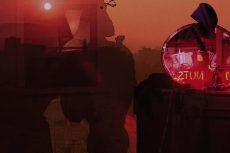“Water and Power.” by Pat O’Neill. June 7, 2015.
- Babobilicons
- Water and Power
Water and Power
“[Water and Power] reveals a modern city as layer over layer of experience, and makes no pretense of reducing Los Angeles to anything like a single, coherent understanding… L.A. is not merely an elaborate reality; it is a nearly overwhelming surreality.”—Scott McDonald, Wide Angle
A latter-day city symphony that was nearly a decade in the making, Pat O’Neill’s Water and Power is one of the most significant experimental films of the 1980s, winner of a Sundance Grand Jury Prize in 1990 and selected to the Library of Congress’ National Film Registry in 2008. Like Roman Polanski’s Chinatown, O’Neill’s film focuses on the relationship of water, in all its forms, to the duplicitous undercurrents of Los Angeles. Superimposing text and surrealist vignettes over images of L.A. streets and vistas of the Owens Valley—a primary water source for the city’s downtown core that is being progressively sucked dry—O’Neill renders L.A. as a true frontier town, perched precariously on the edge of the desert that could one day reclaim it. The size and resolution of the 35mm film image provides a massive canvas for O’Neill’s incredibly precise optical printing work. The baselines for many of his compositions are time-lapsed landscapes, shot on a motion- control camera that allows precise movements to be exactly duplicated in other locales. O’Neill then sutures these shots together with high- contrast images of ghostly figures performing obscure, repetitive actions in a derelict downtown office—suggesting both the traces of the city’s vanished histories and the essential evanescence of the city itself—while George Lockwood’s beautiful sound design layers sound effects, snippets from B movies, and music from a plethora of genres over the visual field. The result is simply one of the most intense cinematic experiences one can have.
Water and Power is preceded by Babobilicons, a surreal masterpiece of time-lapse and optical printing that had a similarly prolonged production history: Daina Krumins took nine years to make the film (during which time she also worked as an optical printer operator at O’Neill’s Lookout Mountain Films), growing mushrooms, moulds and spores in miniature sets in her basement studio.—Chris Kennedy
(These notes were originally written for the 51st Ann Arbor Film Festival, 2013.)
Babobilicons dir. Daina Krumins | USA 1982 | 16 min. 35mm
Water and Power dir. Pat O’Neill | USA 1989 | 54 min. 35mm
Prints courtesy of the Academy Film Archive.
Sunday, June 7 7:30pm
